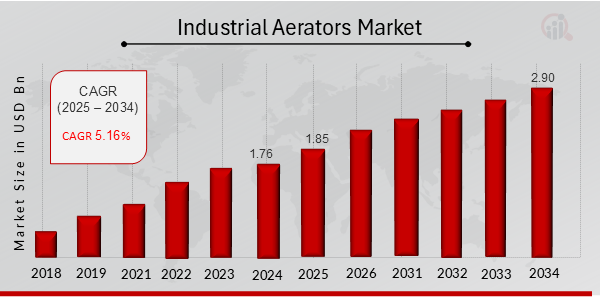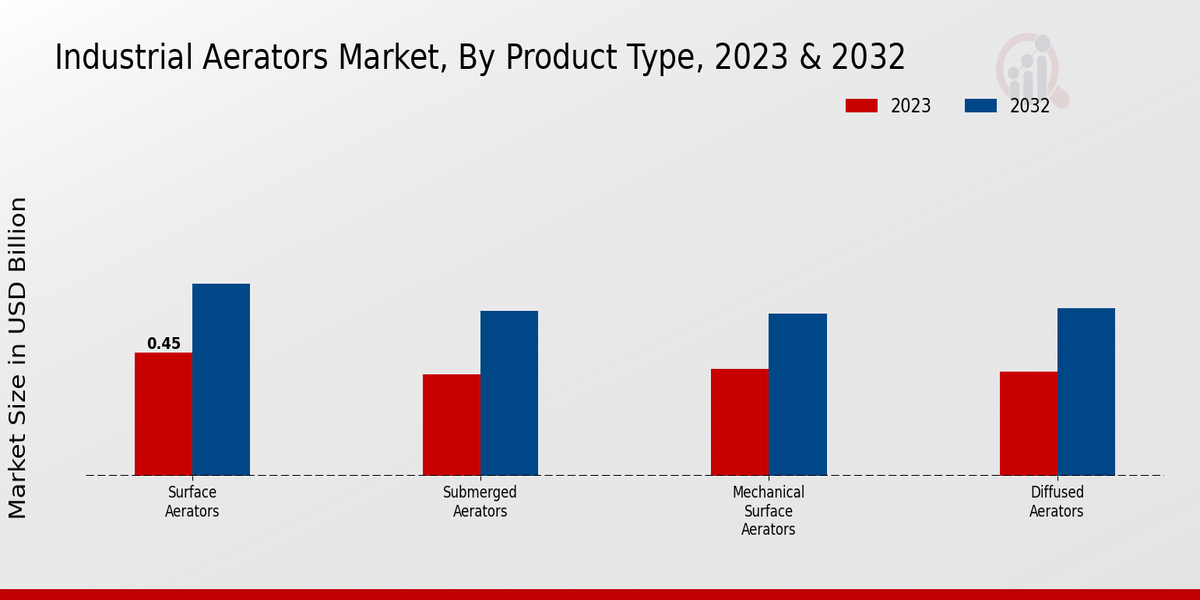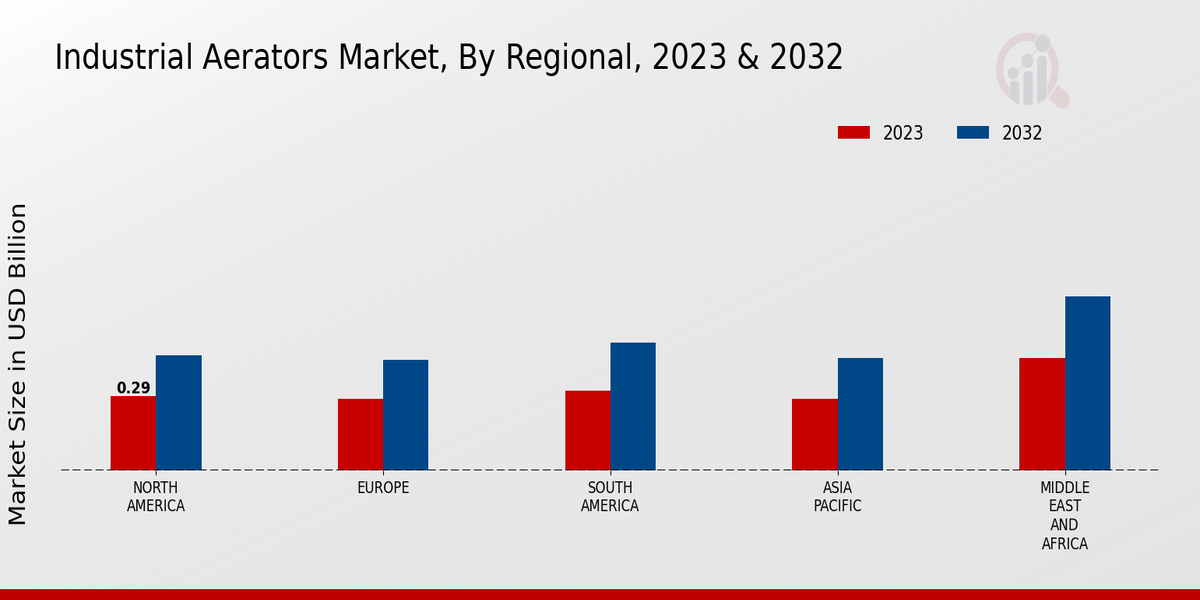Global Industrial Aerators Market Overview
As per MRFR analysis, the Industrial Aerators Market Size was estimated at 1.76 (USD Billion) in 2024. The Industrial Aerators Market Industry is expected to grow from 1.85 (USD Billion) in 2025 to 2.90 (USD Billion) till 2034, at a CAGR (growth rate) is expected to be around 5.16% during the forecast period (2025 - 2034).
Key Industrial Aerators Market Trends Highlighted
Industrial aerators play a critical role in various industries, including wastewater treatment, aquaculture, and power generation. The growing demand for efficient wastewater treatment solutions and the need to improve water quality in industrial processes is driving the growth of the industrial aerators market. Additionally, the rising awareness of environmental sustainability and the need to reduce energy consumption are creating opportunities for aerators with improved energy efficiency.
Recent trends in the market include the adoption of advanced technologies, such as low-energy aeration systems, and the use of advanced materials, such as high-density polyethylene (HDPE), for durability and corrosion resistance.
Figure 1: Industrial Aerators Market Size, 2025-2034 (USD Billion)

Source: Primary Research, Secondary Research, MRFR Database and Analyst Review
Industrial Aerators Market Drivers
Growing Demand for Wastewater Treatment
The growing demand for effective wastewater treatment is a major driver of the Industrial Aerators Market Industry. As urbanization and industrialization continue to expand, so does the volume of wastewater generated. Industrial aerators play a critical role in the treatment of wastewater by providing oxygen to microorganisms that break down organic matter. By enhancing the biological treatment process, industrial aerators help to meet increasingly stringent environmental regulations and protect water resources.
The increasing adoption of wastewater treatment technologies, coupled with government initiatives to improve water quality, is expected to drive the growth of the Industrial Aerators Market Industry in the coming years.
Rising Adoption of Aeration Technologies in Aquaculture
The rising adoption of aeration technologies in aquaculture is another key driver of the Industrial Aerators Market Industry. Aquaculture, the farming of aquatic organisms such as fish and shellfish, requires a controlled environment with adequate oxygen levels to ensure the health and growth of the stock. Industrial aerators provide a reliable and efficient means of oxygenation, improving water quality and reducing fish mortality rates. The increasing demand for seafood, combined with the growing popularity of intensive aquaculture practices, is expected to fuel the growth of the Industrial Aerators Market Industry in the coming years.
Technological Advancements and Innovation
Technological advancements and innovation are also driving the growth of the Global Industrial Aerators Market Industry. Manufacturers are constantly developing new and improved aerator designs to enhance efficiency, reduce energy consumption, and meet the evolving needs of end-users. These innovations include the development of high-efficiency impellers, optimized blade designs, and advanced control systems. As technology continues to advance, the Industrial Aerators Market Industry is expected to witness the introduction of even more innovative and efficient aeration solutions.
Industrial Aerators Market Segment Insights
Industrial Aerators Market Product Type Insights
The Product Type segment of the Industrial Aerators Market is broadly classified into Surface Aerators, Submerged Aerators, Mechanical Surface Aerators, and Diffused Aerators. Each type offers unique advantages and applications in various industrial settings. Surface Aerators, accounting for a substantial share of the market, operate on the water's surface, providing oxygenation through splashing and agitation. Their simple design and low maintenance costs make them suitable for smaller-scale applications. In 2023, the Surface Aerators segment is valued at approximately USD 650 million and is projected to grow at a CAGR of 4.5% during the forecast period, reaching USD 820 million by 2032.
Submerged Aerators, which operate below the water's surface, offer higher oxygen transfer efficiency and are commonly used in larger-scale applications. Their ability to provide uniform oxygen distribution and reduce energy consumption makes them a preferred choice for industrial wastewater treatment plants. The Submerged Aerators segment is estimated to be valued at USD 720 million in 2023 and is expected to grow at a CAGR of 5.2% during the forecast period, reaching USD 950 million by 2032. Mechanical Surface Aerators, a type of surface aerator, utilize mechanical impellers or rotors to create surface agitation and oxygenation.
They are commonly used in industrial settings due to their high oxygen transfer rates and ability to handle high solids content. The Mechanical Surface Aerators segment is projected to grow at a CAGR of 4.8% during the forecast period, reaching USD 250 million by 2032. Diffused Aerators, which introduce oxygen into the water through fine bubbles, offer high oxygen transfer efficiency and are commonly used in deep tanks or lagoons. Their ability to provide uniform oxygen distribution and reduce energy consumption makes them suitable for large-scale industrial applications.
The Diffused Aerators segment is estimated to be valued at USD 520 million in 2023 and is expected to grow at a CAGR of 5.6% during the forecast period, reaching USD 700 million by 2032. The Industrial Aerators Market is driven by increasing demand for wastewater treatment, stringent environmental regulations, and growing awareness of the importance of water quality in various industries. Technological advancements, such as the development of energy-efficient aerators and the integration of IoT sensors for remote monitoring and control, further support the market growth.

Source: Primary Research, Secondary Research, MRFR Database and Analyst Review
Industrial Aerators Market Application Insights
The application segment of the Industrial Aerators Market is categorized into Municipal Wastewater Treatment, Industrial Wastewater Treatment, Aquaculture, Fisheries, and Ornamental Ponds. Municipal Water and Wastewater Treatment held the largest market share in 2023, accounting for over 45.6% of the global revenue. The growing population and urbanization have led to increased wastewater generation, driving the demand for efficient wastewater treatment solutions. Industrial Wastewater Treatment is projected to witness significant growth over the forecast period, owing to stringent environmental regulations and the need for industries to reduce their environmental footprint.
Aquaculture, Fisheries, and Ornamental Ponds applications are expected to contribute to the overall market growth, driven by the rising demand for protein sources and the growing popularity of ornamental fish keeping.
Industrial Aerators Market Power Source Insights
Electric aerators hold a significant share of the Industrial Aerators Market revenue, driven by rising concerns over environmental regulations and a growing focus on energy efficiency. Diesel-powered aerators remain popular due to their reliability and cost-effectiveness, particularly in remote areas. Solar and wind-powered aerators are gaining traction as renewable energy sources, offering eco-friendly and sustainable alternatives. The Industrial Aerators Market segmentation data indicates a growing preference for hybrid aerators, which combine multiple power sources to optimize performance and reduce operating costs.
Market statistics show that the demand for industrial aerators is expected to rise steadily in the coming years, fueled by increasing urbanization, population growth, and the need for efficient wastewater treatment systems.
Industrial Aerators Market Material Insights
The Material segment of the Industrial Aerators Market is expected to grow significantly in the coming years. The market is segmented into various materials such as stainless steel, polyethylene, fiberglass, and rubber. Among these materials, stainless steel is expected to hold the largest market share in 2023, accounting for over 40% of the Industrial Aerators Market revenue. The growth of the stainless-steel segment can be attributed to its high durability, corrosion resistance, and ability to withstand harsh chemicals. Polyethylene is another popular material used in the production of industrial aerators, and it is expected to witness steady growth in the coming years.
Polyethylene is lightweight, cost-effective, and offers good chemical resistance, making it a suitable choice for various applications. Fiberglass is also gaining popularity in the industrial aerators market due to its high strength-to-weight ratio and resistance to corrosion. The rubber segment is expected to account for a small share of the Industrial Aerators Market in 2023, but it is projected to grow at a significant rate in the coming years. Rubber is known for its flexibility, durability, and ability to absorb vibrations, making it a suitable choice for applications where these properties are required.
Industrial Aerators Market Regional Insights
The Industrial Aerators Market is segmented regionally into North America, Europe, APAC, South America, and MEA. Among these regions, North America is expected to hold the largest market share in 2023, owing to the presence of a large number of industrial facilities and stringent environmental regulations in the region. Europe is expected to follow North America in terms of market share due to the presence of a well-established industrial sector and increasing demand for industrial aerators for wastewater treatment. APAC is expected to witness significant growth in the Industrial Aerators Market during the forecast period, driven by the rapid industrialization and urbanization in the region.
South America and MEA are expected to experience moderate growth in the Industrial Aerators Market due to the increasing adoption of industrial aerators for various applications.

Source: Primary Research, Secondary Research, MRFR Database and Analyst Review
Industrial Aerators Market Key Players And Competitive Insights
Major players in the Industrial Aerators Market industry are continuously investing in research and development to improve their product offerings and gain a competitive edge. Leading Industrial Aerators Market players are also focusing on strategic partnerships and acquisitions to expand their market reach and enhance their product portfolio. The Industrial Aerators Market development of innovative and energy-efficient products is also driving growth in the market.
Xylem is a leading global water technology company that provides innovative and sustainable solutions for industrial, municipal, and residential applications. The company's portfolio of products and services includes water and wastewater treatment, pumping and dewatering, and analytics and optimization solutions. Xylem has a strong presence in the Industrial Aerators Market, offering a wide range of products and services to meet the needs of its customers.
Sulzer is another major player in the Industrial Aerators Market. The company provides a comprehensive range of products and services for the water and wastewater treatment industry. Sulzer's products include pumps, mixers, aerators, and other equipment. The company has a strong global presence and serves a wide range of customers in the industrial, municipal, and commercial sectors.
Key Companies in the Industrial Aerators Market Include
Industrial Aerators Market Industry Developments
The Industrial Aerators Market is projected to reach a valuation of 2.90 billion USD by 2034, exhibiting a CAGR of 5.16% from 2025 to 2034. The rising demand for wastewater treatment, increasing urbanization, and stringent environmental regulations are driving the market growth.
Recent developments include the launch of energy-efficient aerators by major players like Xylem and Evoqua Water Technologies. Governments worldwide are investing in infrastructure projects that incorporate advanced wastewater treatment systems, creating opportunities for industrial aerator manufacturers. The adoption of smart technologies like IoT and data analytics is enhancing operational efficiency and reducing maintenance costs, further fueling market expansion.
Industrial Aerators Market Segmentation Insights
-
Industrial Aerators Market Product Type Outlook
-
Industrial Aerators Market Application Outlook
-
Industrial Aerators Market Power Source Outlook
-
Electric
-
Diesel
-
Solar
-
Wind
-
Industrial Aerators Market Material Outlook
-
Stainless Steel
-
Polyethylene
-
Fiberglass
-
Rubber
-
Industrial Aerators Market Regional Outlook
-
North America
-
Europe
-
South America
-
Asia Pacific
-
Middle East and Africa
| Report Attribute/Metric |
Details |
|
Market Size 2024
|
1.76 (USD Billion)
|
|
Market Size 2025
|
1.85 (USD Billion)
|
|
Market Size 2034
|
2.90 (USD Billion)
|
|
Compound Annual Growth Rate (CAGR)
|
5.16% (2025 - 2034)
|
|
Report Coverage
|
Revenue Forecast, Competitive Landscape, Growth Factors, and Trends
|
|
Base Year
|
2024
|
|
Market Forecast Period
|
2025 - 2034
|
|
Historical Data
|
2019 - 2023
|
| Market Forecast Units |
USD Billion |
| Key Companies Profiled |
Fristam, Weir Group, ITT Industries, Evoqua Water Technologies, Pentair, Tsurumi, Ebara, Aerzen, Flowserve, Grundfos, Gardner Denver, Sulzer, Xylem |
| Segments Covered |
Product Type, Application, Power Source, Material, Regional |
| Key Market Opportunities |
Wastewater treatment upgradesIncreasing demand from emerging economiesFocus on energy efficiency.Growing adoption of advanced technologiesGovernment initiatives for water quality improvement |
| Key Market Dynamics |
Increasing Demand for Wastewater TreatmentGrowing Industrialization and UrbanizationGovernment Regulations on Water Pollution ControlTechnological AdvancementsRising Focus on Sustainable Aeration Solutions |
| Countries Covered |
North America, Europe, APAC, South America, MEA |
Frequently Asked Questions (FAQ) :
The global industrial aerators market is expected to reach USD 2.90 billion by 2034, growing at a CAGR of 5.16% from 2025 to 2034.
North America and Europe are the dominant regions in the global industrial aerators market, accounting for a significant share of the market revenue. However, Asia-Pacific is expected to witness the fastest growth rate during the forecast period due to increasing industrialization and urbanization in the region.
Industrial aerators are primarily used in wastewater treatment plants to provide oxygen to microorganisms that break down organic matter. They are also used in aquaculture systems to increase dissolved oxygen levels and improve water quality for fish and other aquatic organisms.
Key competitors in the global industrial aerators market include Xylem, Sulzer, GE Water & Process Technologies, Evoqua Water Technologies, and Pentair. These companies offer a wide range of industrial aerators to meet the diverse needs of customers in various industries.
The growth of the global industrial aerators market is primarily driven by increasing demand for wastewater treatment and aquaculture systems. Additionally, stringent environmental regulations and growing awareness of the importance of water quality are contributing to the market growth.
The global industrial aerators market faces challenges such as high capital costs associated with the installation and maintenance of aerators. Additionally, factors such as energy consumption and noise pollution can impact the market growth.
Key trends in the global industrial aerators market include the growing adoption of energy-efficient aerators, the use of advanced materials for improved durability and performance, and the integration of digital technologies for remote monitoring and control of aerators.
The COVID-19 pandemic had a moderate impact on the global industrial aerators market. While some projects were delayed or postponed, the demand for industrial aerators remained relatively stable as wastewater treatment and aquaculture operations continued during the pandemic.
Opportunities for growth in the global industrial aerators market include increasing demand from emerging economies, technological advancements leading to improved efficiency and performance, and government initiatives to promote sustainable water management practices.
The global industrial aerators market is segmented based on type, application, and region. By type, the market is segmented into surface aerators, submersible aerators, and diffused aerators. By application, the market is segmented into wastewater treatment, aquaculture, and others. By region, the market is segmented into North America, Europe, Asia-Pacific, South America, and the Middle East & Africa.

















